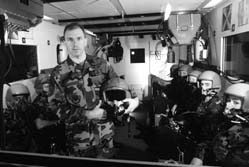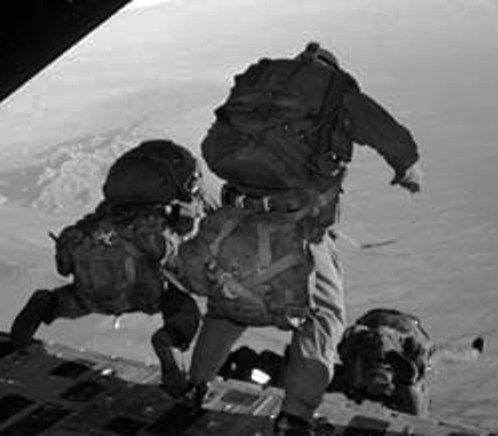High-altitude military parachuting
HALO/HAHO is a military term for a method of delivering personnel, equipment, or supplies from an airlift aircraft that must fly at high altitudes to avoid enemy attacks. [1]
HALO is an acronym for High Altitude-Low Opening, while HAHO stands for High Altitue-High Opening; both different forms of military free-fall (parachute) insertion. [2] [3]
Forms of insertion
The HALO technique is used for delivering equipment, supplies, or personnel, while the HAHO technique is used to deliver personnel only. In a typical HALO/HAHO insertion, the airplane will fly at altitudes of over 10,000 feet.
HALO
The HALO technique is used to airdrop supplies, equipment, or personnel at high altitudes when aircrafts can fly above enemy skies without posing a threat to the load. [4] [5]
Equipment or supplies delivering
For military cargo airdrops, the rigged load is pulled from the aircraft by a stabilizing parachute. The load then proceeds to free-fall to a low altitude where a cargo parachute opens to allow a low-velocity landing. Military personnel will later move to the landing point in order to secure the equipment or to unpack the supplies. [6]
Personnel delivering
See also: SEAL Team SIX.
The origins of the HALO technique could be traced back to SEAL Team SIX of the United States Navy. The team pioneered the use of military free-fall exercises when the U.S. military needed to deliver soldiers to boats and other large operational gears for military personnel delivering or target neutralization. SEAL Team SIX perfected the HALO method by jumping from altitudes upward of 36,000 feet with oxygen masks.
In a typical HALO exercise, the parachuter will jump from the aircraft, free-fall for a few seconds and open his parachute at a low altitude.
HALO jump at McChord AFB
Health risks
See also: Earth's atmosphere, Hypoxia.
At high altitudes of the Earth's atmosphere, the oxygen quantities required for human respiration become thin. A typical HALO exercise will require the use of an oxygen mask, as the parachuter jumps from an altitude upwards of 12,000 feet.
This type of technique is dangerous to human health, as the lack of oxygen can lead to suffering hypoxia. Hypoxia may cause lost of conciousness, which in consequence puts the parachuter in a mortal risk situation, as he can suffer death from landing impact by not being capable of opening his own parachute.
Typical equipment
In a typical HALO exercise, a parachuter will jump with:
- an altimeter
- an automatic rip cord pulling device:
- if the parachuter descends past a pre-set altitude, but hasn't opened his parachute yet, the device will read the air pressure and approximate the current altitude of the parachuter; if this approximation is less than the one pre-set, the device will open the parachute automatically.
- a knife
- a helmet
- a pair of gloves
- a pair of military free-fall boots (designed for ankle support)
- an oxygen bottle and mask (if jumping over 12,000 feet)
HAHO
The HAHO technique is used to airdrop personnel at high altitudes when aircrafts can fly above enemy skies without posing a threat to the jumpers.
In a typical HAHO exercise, the parachuter will jump from the aircraft and deploy his parachute at a high altitude, 10–15 seconds later after the jump (typically at 27,000 feet or so). The parachuter will use a compass to guide himself while flying for 30 or more miles. The soldier will use way points and terrain features to navigate to his desired landing zone, and along the way, he must correct his course for changes in wind speed and direction; making for a tricky navigation problem.
Team jump
The HAHO technique is also used for delivering military teams. The team will jump from the aircraft and form up in a stack while flying in the air with their parachutes. Usually, the parachuter in the lowest position will set the travel course and act as a guide for his other team members.
List of HALO/HAHO capable military units
External links
Books / Online Courses
- US Army (November 1, 1995). Fundamentals of Airborne Operations. Edition B. US Army Infantry School. United States Army. United States of America.
Former HALO/HAHO soldiers sites
Official military sites
References
- USDOD (June 5, 2003). US DOD Dictionary of Military Terms. United States Department of Defense. United States of America.
- USDOD (June 5, 2003). US DOD Dictionary of Military Terms: Joint Acronyms and Abbreviations. United States Department of Defense. United States of America.
- Allen, Jeffrey (July 1997). High Altitude Low Opening (HALO) jump at McChord AFB. United States Air Force. United States of America.
- McKenna, Pat (July 1997). A Bad Altitude. Airman. United States Air Force. United States of America.
- US Army (November 1, 1995). Lesson 3: Airlift Requests and Personnel Used in Airborne. Fundamentals of Airborne Operations, Edition B. US Army Infantry School. United States Army. United States of America.


